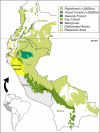Traditional medicinal plant use in Northern Peru: tracking two thousand years of healing culture
- PMID: 17090303
- PMCID: PMC1637095
- DOI: 10.1186/1746-4269-2-47
Traditional medicinal plant use in Northern Peru: tracking two thousand years of healing culture
Abstract
This paper examines the traditional use of medicinal plants in Northern Peru, with special focus on the Departments of Piura, Lambayeque, La Libertad, Cajamarca, and San Martin. Northern Peru represents the center of the old Central Andean "Health Axis," stretching from Ecuador to Bolivia. The roots of traditional healing practices in this region go at least as far back as the Moche period (AC 100-800). Although about 50% of the plants in use reported in the colonial period have disappeared from the popular pharmacopoeia, the plant knowledge of the population is much more extensive than in other parts of the Andean region. 510 plant species used for medicinal purposes were collected, identified and their vernacular names, traditional uses and applications recorded. The families best represented were Asteraceae with 69 species, Fabaceae (35), Lamiaceae (25), and Solanaceae (21). Euphorbiaceae had twelve species, and Apiaceae and Poaceae 11 species. The highest number of species was used for the treatment of "magical/ritual" ailments (207 species), followed by respiratory disorders (95), problems of the urinary tract (85), infections of female organs (66), liver ailments (61), inflammations (59), stomach problems (51) and rheumatism (45). Most of the plants used (83%) were native to Peru. Fresh plants, often collected wild, were used in two thirds of all cases, and the most common applications included the ingestion of herb decoctions or the application of plant material as poultices.
Figures




Similar articles
-
Shadows of the colonial past--diverging plant use in Northern Peru and Southern Ecuador.J Ethnobiol Ethnomed. 2009 Feb 2;5:4. doi: 10.1186/1746-4269-5-4. J Ethnobiol Ethnomed. 2009. PMID: 19187546 Free PMC article.
-
Traditional medicinal plant use in Loja province, Southern Ecuador.J Ethnobiol Ethnomed. 2006 Oct 10;2:44. doi: 10.1186/1746-4269-2-44. J Ethnobiol Ethnomed. 2006. PMID: 17032450 Free PMC article.
-
Ethnomedicinal survey of a maroon community in Brazil's Atlantic tropical forest.J Ethnopharmacol. 2016 Apr 2;181:37-49. doi: 10.1016/j.jep.2016.01.014. Epub 2016 Jan 21. J Ethnopharmacol. 2016. PMID: 26802786
-
An ethnobotanical survey of medicinal plants commercialized in the markets of La Paz and El Alto, Bolivia.J Ethnopharmacol. 2005 Feb 28;97(2):337-50. doi: 10.1016/j.jep.2004.11.022. J Ethnopharmacol. 2005. PMID: 15707774 Review.
-
The globalization of traditional medicine in northern peru: from shamanism to molecules.Evid Based Complement Alternat Med. 2013;2013:291903. doi: 10.1155/2013/291903. Epub 2013 Dec 28. Evid Based Complement Alternat Med. 2013. PMID: 24454490 Free PMC article. Review.
Cited by
-
Ethnobotanical study of traditional medicinal plants used to treat human ailments in West Shewa community, Oromia, Ethiopia.Front Pharmacol. 2024 Jul 19;15:1369480. doi: 10.3389/fphar.2024.1369480. eCollection 2024. Front Pharmacol. 2024. PMID: 39101129 Free PMC article.
-
Cross-cultural ethnobotany of the Baltis and Shinas in the Kharmang district, Trans-Himalaya India-Pakistan border.Heliyon. 2024 Mar 27;10(7):e28613. doi: 10.1016/j.heliyon.2024.e28613. eCollection 2024 Apr 15. Heliyon. 2024. PMID: 38586350 Free PMC article.
-
Closer to assemble: Reply to "far from dismantled" by Root-Bernstein et al., 2023.Heliyon. 2024 Mar 12;10(6):e26705. doi: 10.1016/j.heliyon.2024.e26705. eCollection 2024 Mar 30. Heliyon. 2024. PMID: 38545164 Free PMC article. No abstract available.
-
The influence of exotic and native plants on illnesses with physical and spiritual causes in the semiarid region of Piauí, Northeast of Brazil.J Ethnobiol Ethnomed. 2024 Feb 26;20(1):24. doi: 10.1186/s13002-024-00667-y. J Ethnobiol Ethnomed. 2024. PMID: 38409039 Free PMC article.
-
Perioperative considerations for patients exposed to hallucinogens.Reg Anesth Pain Med. 2024 Feb 15:rapm-2023-104851. doi: 10.1136/rapm-2023-104851. Online ahead of print. Reg Anesth Pain Med. 2024. PMID: 38359966
References
-
- World Health Organization . WHO Traditional Medicine Strategy 2002–2005. World Health Organization, Geneva; 2002.
-
- World Health Organization . Consultation Meeting on Traditional Medicine and Modern Medicine: Harmonizing the Two Approaches. Geneva, World Health Organization; 1999. (document reference (WP)TM/ICP/TM/001/RB/98- RS/99/GE/32(CHN))
-
- World Health Organization . Traditional, Complementary and Alternative Medicines and Therapies. Washington DC, WHO Regional Office for the Americas/Pan American Health Organization (Working group OPS/OMS); 1999.
-
- World Health Organization . Report: Technical Briefing on Traditional Medicine Forty-ninth Regional Committee Meeting, Manila, Philippines, 18 September 1998. Manila, WHO Regional Office for the Western Pacific; 1998.
Publication types
MeSH terms
Substances
Grants and funding
LinkOut - more resources
Full Text Sources
Other Literature Sources


